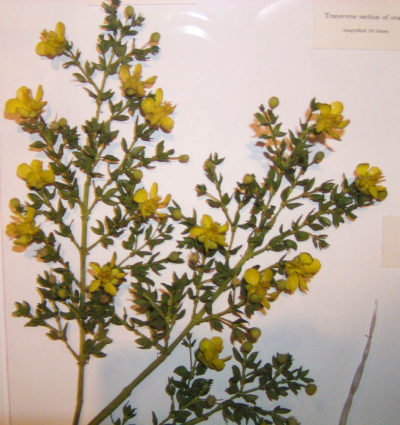
One of my favorite first aid plants for infections is Chaparral (Larrea tridentata, Zygophyllaceae). It has a number of other common names, but in the world of herbal medicine, Chaparral seems to be the most common, common name. This is distinct from the southern California plant community which is also called ‘chaparral’. It is also called Creosote bush due to the similarity of its smell with creosote (a tar derivative). It is in the Zygophyllaceae, a small but showy family, also called the Caltrops family. This makes it related to Guaiacum and Tribulus terrestris (Puncturevine).
Please note, I will be using the name Chaparral and Larrea synonymously throughout this article.
There are a number of reasons I like this plant alongside its medicinal virtues. First, it is very common where it grows, which is throughout a number of desert ecosystems in the southwestern US. So while that is quite a ways from here (Ithaca, NY), when I am out that way I can gather oodles of this fragrant (some would say stinky) plant without impinging on it or its environment’s health.
Botanical Description
Larrea tridentata is a medium-sized branchy shrub with evergreen dark green leaves. The resinous leaves are compound and opposite, with two leaflets attached to each other at the base. The flowers are shiny yellow with five petals. The fruit is a capsule densely covered in white hairs.
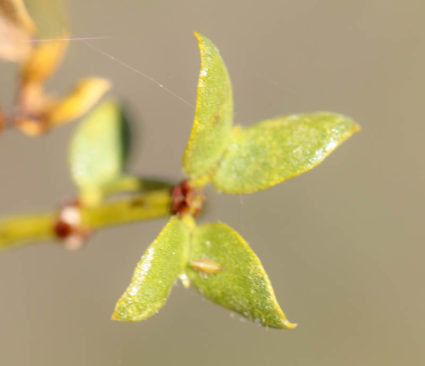
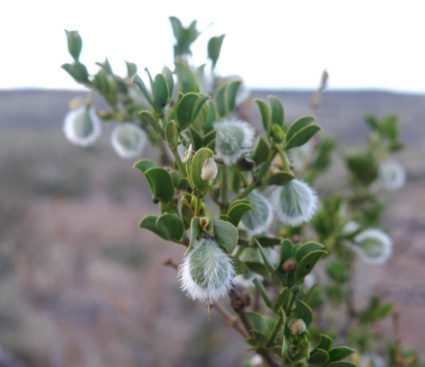
Wildcrafting Tips
Chaparral is often the dominant plant where it grows. Frequently, there are huge colonies of it in its range. To wildcraft, drive into one of these areas and look for plants that have more young growth which is a brighter green color (and often a stronger resinous smell). You will see this distinction more often near the roadside as the scant water in the desert runs off the road and is taken up by the plants. I tend to avoid plants right along roads, especially given the profusion of them nearby. It is fairly easy to gather by either cutting the stems with pruners, or just breaking off the younger stems as the plant stems are brittle. I tend to go between the two methods when gathering. I put them in burlap bags which I find versatile for collecting many plants.
Two ‘Warning’ Stories
Story one; there were a few times when I have gathered Chaparral while on a Southwest road trip with family and friends. With the desert sun beating down through the car windows, the recently gathered wildcrafted plants reeked its strong odor. Sort of like 10,000 of those little pine fresheners, but each one coated with Larrea resin.
So, why the warning? Some of the people who have been with me on these trips needed a few years recovery time to able to be around this plant again without being overwhelmed by the smell. (This may be a bit of an exaggeration, but only by a bit.)
Story number two involves how I process (break down) the plant. In the mid 1990’s I was studying and teaching at Michael Moore’s school in Albuquerque NM. While there, I lived in a basement apartment. I was garbling (a quaint but useful herbal term for refining the plant for use) the recently gathered Chaparral by letting the plant dry on a tarp on the floor. After it dried I would then step on it to separate the leaves off the stems. This is pretty efficient, but as you can imagine, this Larrea Dance releases quite the odor tribute. And the landlords upstairs did not appreciate it. So I put a fan nearby pointing towards the only little window I had down there. After a while they stopped complaining, though I am not sure if it was that they didn’t want the hassle of kicking me out, or they just got used to it.
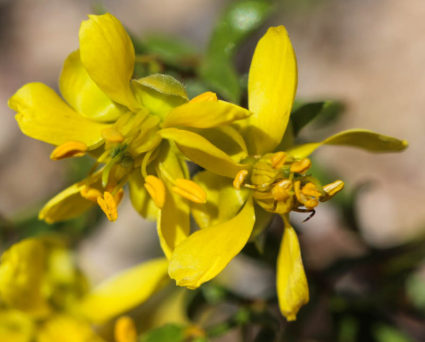
An Interesting Chaparral Fact
Another aspect that makes this such an intriguing plant is its longevity. There is a Larrea stand in the Mojave Desert called the “King Clone” that is a whopping 11,700 years old. Yup, you read that right. This makes it one of the oldest living organisms on earth (as far as measuring this type of thing goes). The original aboveground part of the plant died way long ago, but the plant continues to expand underground sending up new shrubs (clones) which now form a ring. All the plants in this clonal ring are genetically identical, and it has continued to grow and expand since, hmm, lets see, about 9700 BC.
Here is some perspective on what was happening on earth around then; in people-land, we are mainly hunting and gathering, though the nascent skill of agriculture is emerging. And the last big glacial period was ending around then too. At that time in what is now California, a seedling sprouted, grew and continues to this day through the many ages of we call modern human history.
So, counting up the ways I like this plant so far (its medicinal value forthcoming), is for the commonness in where it grows, the ease in gathering and garbling (sans neighbors), and a fascination on how long this plant can live. Plus, after a desert rain the air is pungent with the odor of Larrea, which I find revivifying.
Processing and Medicine Making
After taking the leaves off the stems, there are a couple of ways you can process this plant for medicine. First, you can just dry it for future use. The plant dries pretty easy, just lay it out on some kind of sheet (such as a tarp) in a non-moist environment. It is helpful if the room gets some sunlight to speed the drying process. If you are going to use a dehydrator remember the smell will waft throughout your home, and your dehydrator will smell like Chaparral for a long time to come. This might be problematic if you are going to dry more delicate smelling plants or foods in it later.
We Interrupt this Blog to bring you Another Odd Anecdote
Years ago, I lived in a very drafty moist cabin. To keep most of my dried plants dry, I kept them in jars, buckets and tubs. But I kept my Chaparral in an open box figuring it would resist any molds, etc. A couple of weeks after I had stored it in the aforementioned box, I looked in and all of the Larrea had gone moldy. I didn’t even know that can happen, but it sure did and I had to compost all that hard work and plants gathered from far away. I guess Chaparral is not used to living in a constant moist environment and had no defenses against the pathogen.
Medicinal Preparations
The part of this plant used medicinally is the leaves, though if you have some branches, flowers or seed capsules in with them it will not hurt the medicine. The leaf can be used either fresh or dried, as there is not that much water in them to begin with.
There are a number of preparations that can be made from Larrea. Here is a list of some of the ones I make and use the most (medicinal uses for them are below). Due to the antioxidant properties of this plant, most of these preparations will have a longer shelf life than medicines made from other plants.
- Tincture-tincture with 95% ethanol at about 1:2, or as close to this as you can get while having the leaves covered by the menstruum and a few inches above it.
- Infused oil-soak (infuse) the leaves in extra virgin olive oil, and let them sit for at least 2 weeks in the oil. Cover the leaves with the oil and have a few inches of it above them. Since they resist mold, you can let the leaves stay in the oil for a longer period of time than most plants.
There are two very good reasons to make this preparation. The first is Chaparral’s use as an external antiseptic. The oil alone, or combined with other plants, can be applied directly to wounds. The second reason is Larrea’s strong antioxidant effects. The constituents (chemicals) helps stabilize the infused oil, and by adding the Chaparral oil into other oils or salves, it will slow down their rate of rancidity and give them a longer shelf life. The only drawback to this is its strong taste and smell so you may not want to employ it in preparations like lip balms. - Salve-salves are basically infused oils solidified with beeswax with essential oils sometimes added in. Using Larrea in a salve is similar to using it as an infused oil.
- Tea-tea is a water-based preparation generally prepared with hot water. Chaparral is usually infused (hot water poured on) rather than decocted (cooked) in the water. Remember that if this is for drinking, you may want to use a light touch with the plant, it is strong tasting.
- Honey-an infused honey is when the plant is covered with honey which will eventually extract the plant constituents. There are a few ways of increasing the ability of the honey to absorb these. One is heating it in a double boiler or just keeping the jar near a warm place so that the honey is liquid enough to allow movement of the materials between the plant and the honey.
I have not used Chaparral honey yet, but I am considering it as a burn medicine to have the Larrea augment the honey for this type of treatment. - Capsule-these are plants powdered and put into various types of capsules. There are good reasons to use capsules with Chaparral. First, the plant’s constituents are stable, so the medicinal action will still be potent even after the powdering process. The second is that this plant has a very strong taste so many people will not take it. But capsules can bypass the taste buds. Remember that if there is a lot of ‘Chaparral dust’ on the capsule, it might decrease patient compliance (meaning it will taste bad).
- Compress-a compress (compare to poultice) is prepared from a tea of the plant and then a cloth dipped into the tea is applied to the distressed body area. Chaparral compresses are especially helpful when you cannot directly soak the affected area. You can also soak a bandage with the tea (or tincture) though it is sometimes problematic to keep an area too moist for too long.
- Poultice-a poultice is when the plant is applied directly to the body (as opposed to a tea of the plant, see compress). I tend to use compresses more often as they are less sloppy. One of the most common types of poultice is called a ‘spit poultice’. This is when you chew a plant up and spit it on the hurt area. Good luck with this and Larrea.
- Powder-as mentioned in capsules, the powder of Chaparral is pretty stable and will last a while. A reason to powder it is to combine it with other plants and substances such as clay. It can also be stirred and drank, or put into capsules.
10. Wash/Soak/Sitz/Bath-these are all ways of soaking a body part in Chaparral tea (or tincture if need be). This is one of my favorite ways of using Larrea, making a very strong tea and then soaking an infected body part such as a foot or forearm. I think it is one of the most effective ways of using this plant. To prepare this, just make a very strong tea of the plant and soak the body part in hot, but not painfully hot water. The heat helps by keeping the local pores open allowing better infiltration of the plant constituents. Keep in mind that the water may have infectious material in it so make sure the vessel is washed well and the water disposed of properly.
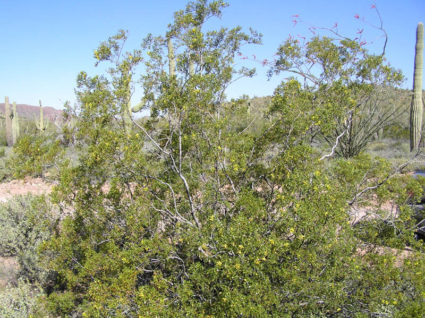
Patient Compliance
An important consideration with Chaparral is how to get people to ingest it. Externally it is not so difficult, but internally this can be quite tricky as the plant is very bitter and for many the taste and smell are quite disagreeable. This is especially true if they are going to have to take it for a while. So when deciding what form (tincture, tea, etc) to give it is important to consider the patient’s ability to actually consume it. For someone used to taking herbal preparations this may not be as difficult. But for someone unaccustomed to drinking plant-based medicines you might want to figure out the easiest form for them to take. If it seems they will not use it, consider using another herb. It is not easy to disguise the flavor of Chaparral, adding honey to the tea just makes it taste sweet yucky. One form to consider are capsules. They have little flavor (unless the outside is dusted with the plant powder) and are fairly stable in powder form. The next most acceptable form is tincture, mainly because you can shoot it down quickly and you don’t need as much of it. You can add the tincture to juice or add flavoring herbs such as Cardamom to the tincture, but probably the best way to get it down is to dilute it, knock it back and follow with a chaser. I would reserve the tea for folks used to herbal medicine.
Medicinal Uses
While there is a wealth of information on the medicinal uses of Larrea, I am going to stick to the most common ways in which I use it. This is mainly in first aid and for various types of infections. If you are intrigued by this plant, I suggest researching other historical and current uses. This plant and closely related species have a long historical usage by people who have lived near it.
Infection
The main way I use Larrea tridentata is in various preparations to help prevent and kill a number of infectious organisms. These include; bacteria, fungi and protozoa. For herbal honesty’s sake, I want to be clear and say I have seen Chaparral not work many times, but it has helped often enough and sometimes where other plants (and drugs) have not. And so I continue to use and recommend it. It is valuable plant that I hope people who read this begin to use more frequently and widely.
In first aid the main common types of infections I see are skin and gut infections. Skin-wise, the most common infectious bacteria are staph (Staphylococcus aureus). Gut infections include bacterial, viral and protozoal organisms that are delivered through food and water. I also occasionally see fungal skin infections such as athlete’s foot.
With staph infections, it is one of a number of remedies that are helpful depending on the strain of staph, the extent of the infection and the individual’s immunological resistance. While this is not going to cover a full staph treatment protocol, this is how I use Larrea in these situations. If the wound is on an area you can put into wash basin (i.e., hands and feet) soak the infected area in a very strong tea of Larrea If it cannot be soaked, use a hot compress. Afterwards alternate between remedies (see Combinations below) which will be applied topically. Apply the Larrea tincture directly on the wound and/or put it on a gauze pad which is then held in place. You may also want to employ other topical and internal plant medicines such as activated charcoal poultices and Echinacea tincture internally. An important note about staph infections is to avoid using sticky tape to hold the gauze in place. When it is removed, the hair that is pulled out can leave a gap for an infection to take place. Use self-adhesive tape such as Coflex or Vet Wrap.. Staph infections are not always easy to treat, and when stubborn they need to be taken seriously. With these types of infections also consider community protection and letting the infected person know that they are contagious. Also, they need to be intelligent with their treatments. And you and they both need to clean up good each time you work together.
Another place to use Larrea is with infectious gut organisms. This gets trickier as it can be hard to tell if it is an infection or a non-infectious disorder such as irritable bowel syndrome. Also, it can be difficult to know which type of infectious organism. I will not go into those details here but if you know the person ate or drank contaminated food or water then consider using Larrea with other herbal medicines along with (but not at the same time as) activated charcoal.
One last place here to consider using Chaparral for is with fungal infections. I have seen it work well with the type of fungi (a Tinea) between the toes and also under toenails. The best way to treat this is with hot Chaparral tea soaks and topical application of the tincture.
To simplify, if you think it is an infection and it is not posing an immediate risk, then consider using Chaparral, either internally or externally.
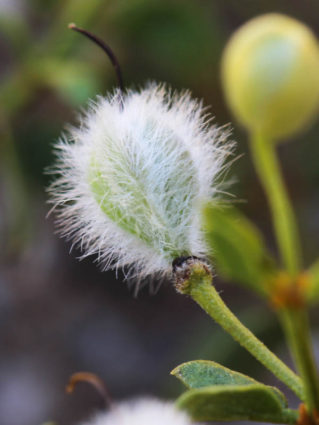
Other Medicinal Uses
Larrea is also used for a much broader array of medicinal uses. It has been well researched due to it containing nordihydroguaiaretic acid (NDGA) which has strong antioxidant properties. The free radical scavenging abilities of NDGA recommend it being helpful in a wide range of diseases. Someday I hope to expand my use of this plant for some of these chronic disease states. If you are interested in learning more just search nordihydroguaiaretic acid
Due to its bitter flavor it can be used as digestive bitter but since it has many other properties it seems better to use a safer (less complex) bitter such as Gentian (Gentiana spp.).
Dosage
It is difficult to give concise dosage guidelines for almost any remedy or treatment but here are some general protocols. When treating an acute infection as with something brought on by ‘bad’ food or water, use a large loading (the first) dose and then use medium amounts regularly for 2 days or so afterwards. To give an example; you and a friend drank some iffy ‘live’ water from a stream near where you were camping in the Rockies. Two nights later you both wake up around 3 am with diarrhea. You are nauseous but not vomiting. Start with about 4 ml (nearly a teaspoon or about 3 full 1 oz dropperfuls) along with some other herbs. Alternate with activated charcoal (but not at the same time). And then take about 2.5 ml (about ½ teaspoon or 2 full 1 oz dropperfuls) every four hours for about 2 days. And then reduce it to about 1.25 ml (a full 1 oz dropper) every four hours for another day or so. It is hard to say how long as it depends on whether your symptoms are getting better. So this is a very broad parameter for treatment.
For external infections, try to soak the infected part in hotish water at least 1-2 times daily. And apply Chaparral tincture throughout the day.

Combinations
While Larrea can be used alone, it also combines well with other plants. What percentage of the plant you use in a formula depends on the main health benefit you are seeking. For instance, if you are using it for an infected wound, you might use a larger percentage of Chaparral as it is a strong disinfectant. But if you are looking to treat inflammation, you might add plants that have as stronger antiinflammatory action.
For staph infections in particular, it is helpful to use a mix of plants and change them after every few wound care treatments. This seems to help keep the staph infections at bay.
- Antibacterials-Echinacea (Echinacea spp.), Boneset (Eupatorium perfoliatum), Osha (Ligusticum porteri), Goldenseal (Hydrastis canadensis) Oregon graperoot (Berberis spp), Barberry (Berberis thunbergii), Yarrow (Achillea millefolium).
- Antiinflammatories-Arnica (Arnica spp.), Yarrow (Achillea millefolium), Willow (Salix spp.), Turmeric (Curcuma longa), Licorice (Glycyrrhiza spp.)
- Astringents-Anemopsis californica (Yerba mansa), Oak (Quercus spp.), Witch hazel (Hamamelis virginiana), Geranium root (Geranium maculatum).
- Vulneraries-Calendula (Calendula officinalis), Yarrow (Achillea millefolium), St. Johnswort (Hypericum perforatum).
Safety Profile
There are a number of concerns about the internal use of Larrea mainly involving liver damage. Again, as with the medicinal uses section, please look through the literature to learn more. As with many studies, it is hard to interpret the causality of Larrea creating damage to the liver and other organs. But here is my take on it, it is a strong herbal medicine; in taste, smell and effects. It has a decisive action on infections. My recommendation is that for external use, it seems safe enough unless it was put into a deep wound over a long period of time which would allow for systemic uptake. Internally, I would try to limit its use to about 2 weeks or so. If it has not helped by then it might be time to change the medicine. Also, the flavor tends to limit people’s ability to take it, so if you are using capsules, which have no flavor, you may want to set a regular dosage with a time limit.
Any quantity I suggest here is just conjecture. I have no way to evaluate how much a person can take or for how long. You will have to figure this out for yourself using common sense guidelines, information gleaned from outside sources and the knowledge of your own body.
Two special notes. Internally I would suggest people with frank liver damage such as Hepatitis C avoid it. I don’t know any studies to confirm or deny this, but there are other plants that might work and frankly Larrea just seems strong.
Also, while there is no clear evidence of Chaparral interacting with any conventional drugs (such as with CP450 pathways), it seems possible that it might. So if you are taking drugs that are essential for your well being, you may want to have some lab tests performed to make sure your markers haven’t changed.
I realize that this may seem hedging but it is the best information I feel I can offer. So, to reiterate, Larrea is strong and could possibly cause some health problems taken in large doses over a long period of time. Avoid it when the liver is damaged and be cautious taking it regularly if you are on any life-sustaining medications. I think using Larrea for first aid situations, notably infections, is reasonably safe due to the duration it is used.
Chaparral is used by some people as a cancer treatment, and I frankly I feel unqualified in giving any response to this. I don’t have enough information and would just suggest that anyone with serious health disorders to make sure to be seen by knowledgeable people.
Considerations
Please remember that when helping people to keep the patient’s needs first. Their getting well is more important than your desire to experiment with herbal medicines. If there is an infection that is quickly getting out of hand, it may be time for medical intervention. It is not that antibiotics always help but sometimes they might work better or in conjunction with Larrea and other herbs.
Conclusion
Larrea tridentata is a useful plant for number of reasons. First, it has strong infection fighting potential and can be used for number of different infective organisms. This makes it a useful plant for anyone preparing to do first aid in an outdoor situation, especially at a longer event. Next, it is a common plant where it grows and a lot of it can be gathered without harming the plant population or the environment it grows in. It is soluble in a wide variety of menstruums and can be prepared into a number of helpful medicinal preparations. It has strong antioxidant properties so it maintains its medicinal strength for a lengthy period and can be added to other medicines as a preservative. For all of these reasons, plus the way it makes the desert smell after a rainfall, I hope that others learn to appreciate and use this plant.

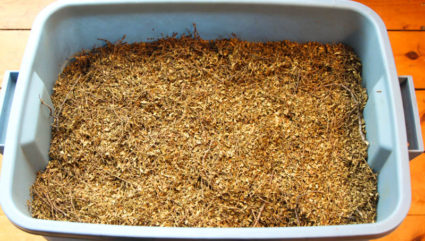
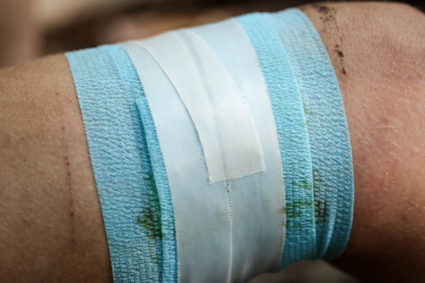
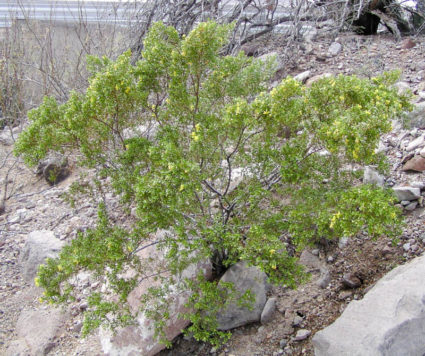
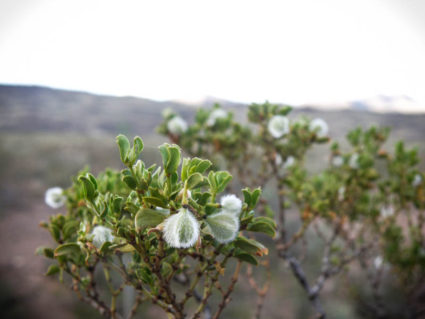

One can always learn more about Chaparral. One of first plant spirits. Thank you.
Dear 7 Song
Thank You for this information. I found myself being attracted to this plant, while I was camping in Borrego Springs Ca. last year. So I checked it out on a site Las palitas that sells Ca. native plants, and it seemed like a doable for my Ca. native garden. Bought one last week while staying in Borrego Springs again, surrounded by the creosotes. When I got home i looked it up for the medicinal value. Yours was by far the most informative. I have been of late making a lot of tea from my garden mostly Melissa and thyme, but recently aguired some Mugwort (dream plant) and have been cautiously working with it. It turns out I can really use this creosote plant, having arthritis, and a post nasal drip now called UACS for upper airway cough syndrome, which I have made some major head way by using Boron, which has been getting rid of my rossca (red skin) and bumps and chronic black heads, which i recently discovered on line, were caused by derminex mites, which I think went up my nose and caused the UACS. Now I really want to build my immune , urinary, and cardiovascular systems and really get healthy. I just finished my first cup of creosote tea, it’s a doable for me. I’ll let you know if any thing miraculous happens, like with the Boron.
Best regards
Pam
Nothing mentioned in your article regarding cold sores. Have you heard of of used for HPV cold sores?
I see so much negative hype around toxicity issues of Chapparal, can you speak to that at all?
Larrea is wonderful………….. BUT one slight problem with internal use in humans, if taken over a period, there is a build up of BILIRUBIN, and there is pain in the liver area. This stops with the stopping of the herb , with no damage to liver ,etc. I know because I used it internally with success. But when made into an ointment, for external use …………….. it is absolutely amazing
The Apaches used this herb and found it very clever.
Larrea was banned for about 2 years in the UK, BUT when it was found that damage doesn’t occur with the herb, it was re- allowed again HURRAY……………………
Roger.
Back in the 70’s, an herbalist gave me creosote herb for trichomonas . This was long ago,
and i believe i was to drink the tea 2 times a day and douche with it once a day.
I believe this was to be followed for 7 days. I remember being healed with this treatment.
i am currently with bacterial vaginosis. I am on a severely restricted diet, for the last 2 months,
No sugars, very low carbs. I have had 3 different vaginal treatments (golden seal echinacea
probiotic suppositories, metronidazole gel, boric acid probiotic suppositories) each one for 10
to 14 days, i am doing so many things to help cure the BV. Do you think the creosote as described above would be a possible treatment for the BV?
Any recommendation or advice would be helpful
Thank you so much, sincerely, laurie needham
Dear 7 Song,
Although I occasionally drink the tea, my preferred method of interacting with Larrea is in the sauna. A strong tea poured over the hot rocks produces a vapor much like an earthy eucalyptus. However, NDGA is a strong chelating agent (dissolves and binds metals), so I avoid using metal utensils, preferring a clay pitcher. I suppose I absorb some of the most volatile components in my lungs as well as through my skin. While not entirely topical, I doubt I risk any toxicity from the Plant as your tolerance from the odor keeps the level very small. You only need a tea ball quantity to make a pitcher of strong tea for the sauna. Some research suggests the Pima Indians used a similar process to make their sweat lodges suitable for child birth, also lining the inside with Larrea branches.
Bob
I purchased some Chaparral liquid herbal extract when my husband had cancer. He has passed away now. I have recently developed bad arthritis in my hands and wrist area and was wondering if this extract liquid would help?
If it will – HOW should I use it??
Hello,
HI. Can you connect me with a wildcrafter who could get us one pound of wildcrafted Chaparral? Need leaf, stem, flower and fruit if possible. We would like to get it whole. Thanks, Michael Volchok (formerly of Blessed Herbs.) Its for my wife. Blessings.
Can Chaparral/governadora be used to help prevent wrinkles? Somebody told me that if I boiled two teaspoons of this plant in some water, and then apply the liquid to my face with a cotton ball that this would help me prevent wrinkles. Basically, if used externally it can keep one’s skin looking young. So can someone out there answer my question?
Dear 7Song,
I have found that if you take Chaparral tea for more than 21 days in a row, this is when it can have adverse affects on the liver and body. There needs to be at least a month’s break in between dosing with the tea, then only for another 21 days.
And, yes, it does cure cancer. I have seen the results myself and with others I have given it to. But some people may have an allergic reaction to the tea, so people need to be aware that this is not a cure all for everyone with cancer.
This plant as a decoction will expediently remove Tinea Versicolor.
I was told that it shrinks Fibroids. Do you have knowledge of this?
I don’t know about this use of Larrea Tanya, but I would be cautious with internal use.
I’m planning on making a hydrosol from creosote and adding it to a lotion I make. Very excited to see how it goes!
I hope it went/goes well Adrianna, a might stinky I imagine.
I hope your Larrea hydrosol experiment went well Adrianna
~7Song
I am experimenting with using a small dose of dried larrea herb to sanitize my hot tub. I have a little plastic fish that I bought at the hot tub place to put essential oil in for the hot tub. I have put a teaspoon full of dried chaparral herb in this little plastic fishy and let it float on top of the water. So far this season I have only put one teaspoon of chlorine in the tub. The only side effect I have seen is the water is a green color. I reason that if you can put it in a bath why can we not put it in a hot tub. I don’t see any side effects on my body so far and have been using chaparral now for about one month and I get in the tub every day.
Can you comment, thanks
Celeste
Hello Celeste
That is a very interesting idea. I do not know if the amount you use would suffice to kill water-borne organisms. The amount you use seems like it would not be harmful for people bathing. I do not wash my soaking tubs with Larrea though, I use bleach of iodine for that.
~7Song
A few years ago when I was pouring sweat lodges the medicine man Inwas studying with suggested I make a tea of chaparral and pour it on the stones to help people ‘sweat harder’ thus detoxing their bodies. I prepared a gallon of the tea and took it into the lodge. In the lodge were a mixed group of tens and adults from a boarding school. In the second round which was dedicated to cleansing the body In began using the tea as directed. On young man became agitated and said he felt like he was going to be sick. I instructed him to make a hole in the sand and vomit into it which he did. Instantly the lodge smelled like some sort of chemical solvent. It reminded me of toluene. I said, “What is that smell?” Someone answered, “There is only one thing that smells like that, meth.” I asked the young man if he had used meth. He said he had. I asked how long since his last use to which he replied, “Four years.” This is pretty anecdotal but iis my first hand experience. I don’t pour sweats anymore but have advised a few people intent on getting clean from meth use or exposure to try a sauna or sweat bath with steam from chapparal tea.
I was in Arizona and California couple years ago and my younger son was six. Not sure the cause but the symptoms were my son had very very sweaty and stinky feet especially unusual for his age. The guy I was dating at that time his mother was really Earthly and knew a lot about working with natural medicines. He showed me this bush and told me to boil it like a tea like you described in your article. And just used it as a soap for my son’s feet. I only used it once but the next day my son came home with dry feet and they did not smell. So to add that to medicinal purposes I do believe this is a very good solution for feet odor. good to know for people that do stuff for with this condition thank you and God bless
Adrianna, I also have distilled Larrea to great success. Love adding it to cremes, etc. Also the hydrosol makes a great smudge. I personally LOVE it’s scent.. but then I’m from Tucson.
Also, 7Song, a friend here uses a fine powder of Larrea on the skin for prickly heat. Works well.
Love your blog – thanks so very much for what you offer!
I made an oil infusion using the fresh cresosote. First I washed the leaves to remove any residue and then I blotted them dry before putting the leaves into a jar. I fully covered the leaves with extra virgins olive oil. Do you think the moisture on the leaves from washing them previously will affect the oil process ? Thank you for your support.
~Amunah
This is intreasting, would like to order some , would like to know how to make a salve, and a cleaners for my face. can you give me any information?